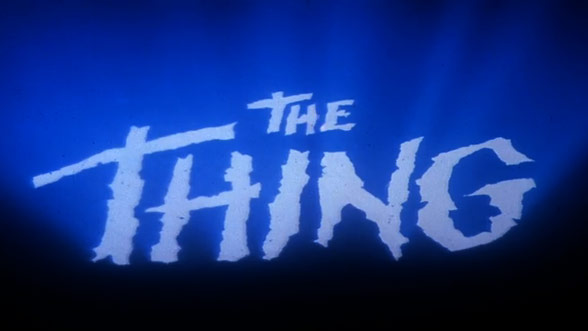Nothing reveals an artist’s talent quite like telling a story which has been told before. Lovecraft began a theme of alien Antarctic horror, and Campbell spun those elements into a new narrative. The Thing from
Nothing reveals an artist’s talent quite like telling a story which has been told before. Lovecraft began a theme of alien Antarctic horror, and Campbell spun those elements into a new narrative. The Thing from Another World recast that story into the mold of a 1950’s monster movie, letting the sensibilities of that era shine through the assimilated parts of its source material. In 1982, The Thing both returned the tale to its roots, and put the unique talents of John Carpenter and his cast and crew on display.
Where Campbell acknowledged no influence from Lovecraft, Carpenter has been more open about his familiarity with the father of cosmic horror. The sensibilities the two share come out in elements of The Thing which Who Goes There? lacks but which are present in At the Mountains of Madness. Where Campbell’s mutant monster has, perhaps, some sort of fixed original form, Carpenter’s seems to be nothing but raw protoplasm, more akin to the shoggoth. He also pays attention to the importance of flight conditions and machinery, something crucial to Lovecraft’s Antarctic story. The isolation of the men at the base is displayed against the stark vista of endless snow and towering mountains. But where Lovecraft’s vast mountains concealed and endless maze of secrets, Carpenter’s exist more to highlight the isolation and ensuing paranoia which fuel his movie.
This return to the theme of paranoia is only one of several ways Carpenter also brings us back to Who Goes There? The movie is far closer to the novella’s plot than the 1951 version. The serum test is back, the names of all the characters, and Macready’s speech in particular, declaring that he knows he’s not a thing, but he’s not too sure about anyone else. The return of those characters also erases The Thing from Another World’s contrast between soldier and scientist. While not everybody in this version appears to be an academic, neither class is less sane that the other, and all display elements of the masculine bravado present in the novella.
But The Thing is not merely a return to the roots of the story: it goes beyond them. Campbell’s version includes a single murder of one human being by another. Carpenter includes this element, this death not directly due to the thing. But where the original merely used it to highlight the agitation of the characters, here it occurs in an open struggle for power within the base. That struggle for control is not present in Campbell, where our heroes have a much greater tendency to cooperate for the common good. Where Who Goes There? throws a wrench in the serum test through the intervention of the alien, uniting them against an outside enemy, Carpenter uses it to turn their suspicions towards each other. The grotesque visual effects also drive home the way in which the unfamiliar and hostile is always lurking behind the familiar in Carpenter’s version. That tension carries through to an ending that goes just a scene longer than Campbell’s story, and confirms its status not merely as weird tale, but a chilling classic of the horror genre. Dread pervades it.
Perhaps the whole saga is best summed up in the story of the dogs. Lovecraft includes sled dogs as a piece of equipment important to a scientific expedition. When confronted with the alien menace, they fight nobly, died horribly, and earn our sympathy. Likewise, Campbell makes us sympathize with dogs as they trapped and picked off by the horrid thing. The 1951 adaptation shows them fighting the monster, and once again suffering at its hands and earning our pity.
But for Carpenter, the dogs are something else. The movie opens with a helicopter chase across the tundra. The mysterious Norwegians, clearly frightened out of their minds, are trying to kill it. They will die trying to kill it. Once it is on the base, we follow it. It observes the men. The camera lingers. The music drives up the tension. Something is not right. This dog does not evoke our pity. It evokes fear.
From start to finish, The Thing is a masterpiece of tension, of dread, and of horror. In some ways, it may be more Lovecraftian than Lovecraft.
